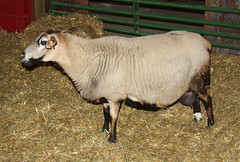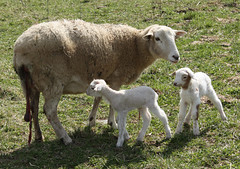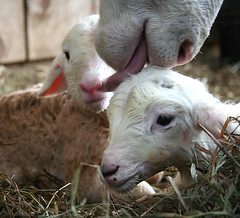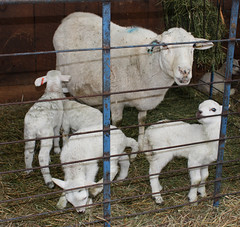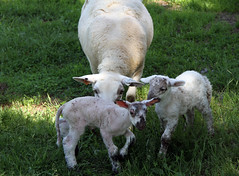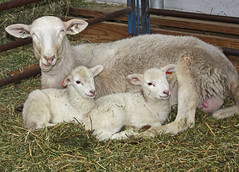Mary had a little lamb . . . or two
Spring lambing
Mother Nature meant for sheep to mate in the fall so that
lambs would be born in the spring when the weather is mild
and the grass is plentiful. This scenario offers the best
chance for lambs to survive and thrive. Of course, it also creates a food supply for young predators that are born in the spring.
Ewes are mostly "short-day "breeders. When day length becomes shorter (in
the fall), this triggers the ewe's brain to release hormones that
jump start her reproductive system. The further away from the
equator the sheep breed originated, the more likely it is to exhibit
these seasonal breeding patterns.
Conversely, sheep breeds developed
in the tropics or nearer to the equator are less likely to display
seasonal breeding patterns. Breeds in the U.S. that have less
seasonal breeding patterns include the Dorset, Rambouillet, Polypay,
Karakul, Merino, Finn, and hair sheep.
Ewes are also called "seasonally, polyestrus" because their reproductive
cycle is controlled by the photoperiod (season) and they come into heat
(estrus) every ~17 days (until they become pregnant), but only during their fertile period. Photoperiod
is the relationship between light and dark in a 24-hour period. In fact, it is possible to manipulate the photo period and "fool" ewes into thinking it's fall and time to breed.
During their fertile period, ewes will come into estrus (heat)
every approximately 17 days until they are bred or their fertile
period is over. Only during estrus will a ewe allow a ram to mate
her. The duration of estrus is 24 to 36 hours. A ewe in heat will
seek out the male. She may sniff, lick, or nuzzle him. She may
fan her tail. The classic behavior response of the ram when he
detects a ewe in heat is to lift his nose in the air and curl
his upper lip. This is called the Flehmen response. Many mammals exhibit the Flehman response.
First-time moms
Though it depends upon breed, nutrition, and management, ewes
can become mothers by the time they reach their first birthday.
This is okay if the ewe lamb has achieved approximately two-thirds
of her mature size (weight) before being bredand is fed and managed separately from the mature ewes. Thus, for some
producers, it is commonplace to breed well-grown ewe lambs when
they are 7 to 9 months of age. Other producers wait until their
ewes are 18 months old before breeding them to lamb as 2 year
olds. Different breeds of sheep reach puberty (sexually maturity)
at different ages.
Rams
A healthy, mature ram can probably mate 100 (or more) ewes during
a breeding season, though a ratio of 1 mature ram to 35 to 50
ewes is more common to make sure lambing is not too spread out.
Seven to 8 month old ram lambs that have achieved approximately
50 percent of their mature size can be used for breeding. Ram
lambs are usually put in with fewer ewes, 15 to 25. It's best not to mix young rams with mature rams. Some rams
may show a preference for ewes of their own breed or kind and vice versa.
Artificial insemination
Artificial insemination (AI) is less common and much more difficult in sheep than other
livestock for several reasons. The ewe has a more complicated
cervix than other animals, making it difficult to pass a standard insemination rod
through her many cervical rings. Ewes show fewer visible signs
of estrus, making heat detection more difficult. A teaser ram
is often used to detect heat or timed insemations are done, after the ewes have been prepped with artificial hormones. However, good conception rates are possible when ewes are inseminated with fresh semen deep into
the vagina. Good results can also be achieved if frozen semen is injected
into the uterine horns via a surgical procedure called laparascopy.
Trans-cervical AI requires special equipment and is still being perfected for sheep.
Gestation
A ewe is pregnant for 142 to 152 days, approximately five months
or slighter shorter. Pregnancy is also called gestation. Since
ewes gestate for only five months, it is possible for them to
lamb more often than once per year. While annual lambing is most
common, lambing intervals of 8 months are also realistic, especially
in the tropics and with breeds that are less seasonal in their
breeding habits. Cornell University has developed the STAR lambing season, in which ewes have the opportunity to produce lambs five times during a three year period.
Extra food
During her last month of pregnancy, a ewe needs extra nutrition
because her lambs are growing rapidly inside of her and her mammary
(udder) tissue is developing. Approximately 70 percent of fetal growth occurs during
the last month of pregnancy. The growth of the fetus(es) also
reduces the ewe's rumen capacity, making her require a more-nutrient dense diet, especially if she is carrying multiple fetuses.
If a ewe doesn't get enough feed during late pregnancy, she may
get sick because her unborn lambs are taking most of her nutrients. Thin and fat ewes and ewes carrying multiple fetuses are
most prone to a metabolic disorder called pregnancy toxemia (or ketosis), caused by an inadequate intake of energy (calories) during late pregnancy. For this reason, it is common
to feed some grain during late gestation. On the other hand, if a ewe
eats too much feed, especially grain, during late pregnancy, she may have trouble delivering
her lambs because they may get too big to fit through her pelvic cavity. Fat ewes are also more
prone to having problems at lambing time.
Vaccinations
It is usually recommended that ewes be vaccinated during late pregnancy
for the clostridial diseases that most commonly affect lambs: Clostridium perfringens type C & D (overeating
disease) and tetanus. Clostridial diseases are caused by gram positive bacteria that are commonly present in the environment and/or the gut of the sheep.
By vaccinating the pregnant ewe, the lambs
acquire temporary, passive immunity when they drink the colostrum, the first
milk produced by the ewe after lambing. In fact, a pre-lambing vaccination is the only way to protect lambs against type C enterotoxemia and to provide protection for early docking and castration, though anti-toxins can be administered to provide immediate, short-term immunity.
Periparturient egg rise
A ewe's natural-acquired immunity to internal parasites (worms + coccidia) is weakened around
the time of lambing. Scientists call this phenomenon the "periparturient
egg rise." The periparturient egg rise often occurs at the same time hypobiotic (inactive) worm larvae are resuming their life cycles in the spring. Thus, it is a common practice to deworm ewes
during their last month of pregnancy. A dewormer that is effective against hypobiotic larvae should be used.
Due to the widespread emergence of drug-resistant worms, another
strategy is to increase the protein content of the late-gestation ration,
as the primary parasite that affects sheep is a blood sucking
worm (barber pole) that causes blood and protein loss. Higher
protein rations have been shown to reduce fecal egg counts in periparturient
ewes. If deworming is done, it is recommended that treatment be applied selectively to ewes that need treatment or would benefit from it. For example, if ewes are scanned for fetal numbers, those carrying multiple births can be selected for deworming, while those with single births can be left untreated.
Lambing
Ewes usually give birth to 1 to 3 lambs at each birthing event.
Birthing is called lambing. The technical term for all species is parturition. Twin births (two babies)
is most common in well-managed flocks and with many breeds of sheep.
First-time moms, especially yearlings, are more likely to have
single births, though twins are not uncommon in some breeds. Ewes
produce their largest litters of lambs when they are between the
ages of 3 and 6.
There are some breeds of sheep that average more than two lambs
per litter. In the U.S., the most prolific sheep breeds are Finnsheep
and Romanov. The hair sheep breeds (Katahdin,
St. Croix, and Barbados Blackbelly) also tend to be quite prolific, with mature ewes averaging more than two lambs per lambing. The East Friesian, a dairy breed, is also known for its high lambing rate.
The more lambs a ewe has the more feed
she needs to produce milk for them. Oftentimes, extra lambs
need to be cross-fostered onto other ewes or artificially reared. Prolific
breeds are not recommended for novice shepherds or in situations
where nutrition or management are limiting factors.
Because some sheep are raised in more difficult environments, sometimes
it's more desirable for a ewe to have just one lamb. This is because
there may not be enough food for the ewe to support the growth
of two lambs. If the flock has to travel far for food and water,
it's usually better to have one strong lamb than two or three
smaller lambs that may struggle to keep up. Smaller, weaker lambs
that lag behind the flock are more likely to starve, die from exposure, or be killed by predators.
Birth weights
The weight of newborn lambs varies by breed, sex of lamb, litter
size, and ewe nutrition. The lambs from medium to small breeds
are similar in size to human babies, usually between 5 and 12
pounds, with an average of 8 to 10 pounds. When birth weights get
too large (relative to the size of the breed or cross), difficult births
can be encountered. In fact, there is a quadratic relationship between birth weight and survival. Medium-size babies (for the breed or cross) tend to have the highest
survival rate.
Learn more about
lambing=>
<= RAISING SHEEP




